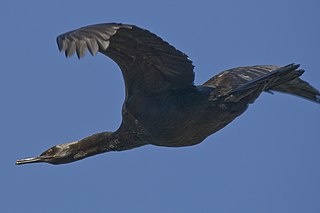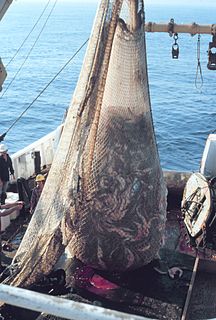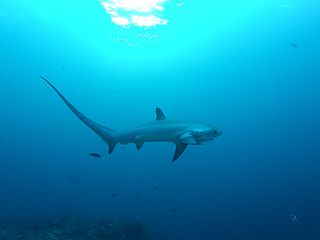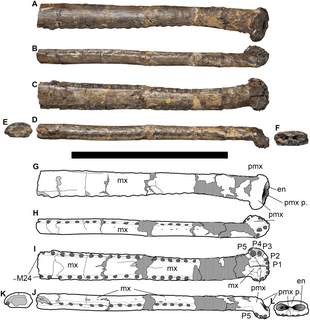
Clay is a finely-grained natural rock or soil material that combines one or more clay minerals with possible traces of quartz (SiO2), metal oxides (Al2O3, MgO etc.) and organic matter. Geologic clay deposits are mostly composed of phyllosilicate minerals containing variable amounts of water trapped in the mineral structure. Clays are plastic due to particle size and geometry as well as water content, and become hard, brittle and non–plastic upon drying or firing. Depending on the soil's content in which it is found, clay can appear in various colours from white to dull grey or brown to deep orange-red.

The ring ouzel is a European member of the thrush family, Turdidae. It is the mountain equivalent of the closely related common blackbird, and breeds in gullies, rocky areas or scree slopes.

The pelagic cormorant, also known as Baird's cormorant, is a small member of the cormorant family Phalacrocoracidae. Analogous to other smallish cormorants, it is also called the pelagic shag occasionally. This seabird lives along the coasts of the northern Pacific; during winter it can also be found in the open ocean. Pelagic cormorants have relatively short wings due to their need for economical movement underwater, and consequently have the highest flight costs of any bird.

Trawling is a method of fishing that involves pulling a fishing net through the water behind one or more boats. The net that is used for trawling is called a trawl.

The brown-headed gull is a small gull which breeds in the high plateaus of central Asia from Tajikistan to Ordos in Inner Mongolia. It is migratory, wintering on the coasts and large inland lakes of the Indian Subcontinent. As is the case with many gulls, was traditionally placed in the genus Larus.
The pelagic zone consists of the water column of the open ocean, and can be further divided into regions by depth. The word "pelagic" is derived from Ancient Greek πέλαγος (pélagos), meaning 'open sea'. The pelagic zone can be thought of in terms of an imaginary cylinder or water column that goes from the surface of the sea almost to the bottom. Conditions in the water column change with distance from the surface (depth), e.g. the pressure increases; the temperature, and the amount of light decreases; the salinity, the amount of dissolved oxygen, and micronutrients (e.g. Fe++, Mg++, Ca++) all change. Depending on the depth, the water column, rather like the Earth's atmosphere, may be divided into different layers.

Thresher sharks are large lamniform sharks of the family Alopiidae found in all temperate and tropical oceans of the world; the family contains three extant species, all within the genus Alopias.

James Brown was a Virginia-born American lawyer, planter and politician who served as a Secretary of State for the new state of Kentucky, and later as U.S. Senator from Louisiana, and Minister to France (1823-1829) before his retirement and death in Philadelphia.

William Clay Matthews Jr. is a former American football linebacker who played for the Cleveland Browns and the Atlanta Falcons of the National Football League (NFL). He was drafted in the first round by the Cleveland Browns and played in 278 games over 19 NFL seasons, which initially ranked him at number 17 among most games played. Matthews had 1,561 tackles in his career, the third most in NFL history.

Cassius Marcellus Clay, nicknamed the "Lion of White Hall", was a Kentucky planter, politician, and emancipationist who worked for the abolition of slavery. He freed the slaves that were handed down as his inheritance from his father. Those freed slaves were allowed to stay and were paid a wage. He was a founding member of the Republican Party in Kentucky, and was appointed by President Abraham Lincoln as the United States minister to Russia. Clay is credited with gaining Russian support for the Union during the American Civil War.
Pelagic sediment or pelagite is a fine-grained sediment that accumulates as the result of the settling of particles to the floor of the open ocean, far from land. These particles consist primarily of either the microscopic, calcareous or siliceous shells of phytoplankton or zooplankton; clay-size siliciclastic sediment; or some mixture of these. Trace amounts of meteoric dust and variable amounts of volcanic ash also occur within pelagic sediments. Based upon the composition of the ooze, there are three main types of pelagic sediments: siliceous oozes, calcareous oozes, and red clays.

Muraenosaurus is an extinct genus of cryptoclidid plesiosaur reptile from the Oxford Clay of Southern England. The genus was given its name due to the eel-like appearance of the long neck and small head. Muraenosaurus grew to lengths between 5 metres (16 ft) and 6 metres (20 ft) and dates roughly to between 160 Ma and 164 Ma in the Callovian of the middle Jurassic. Charles E. Leeds collected the first Muraenosaurus which was then described by H. G. Seeley. The specimen may have suffered some damage due to the casual style of Charles Leeds’ collection. The first Muraenosaur was recovered with pieces missing from the skull and many of the caudal vertebrae absent. Because the animal was described from Charles Leeds’ collection it was given the name Muraenosaurus Leedsi. M. leedsi is the most complete specimen belonging to the genus Muraenosaurus and also the only species that is undoubtedly a member of the genus.. Two other species have been tentatively referred to as members of the genus Muraenosaurus: M. reedii and Picrocleidus beloclis

The pelagic thresher is a species of thresher shark, family Alopiidae; this group of sharks is characterized by the greatly elongated upper lobes of their caudal fins. The pelagic thresher occurs in the tropical and subtropical waters of the Indian and Pacific Oceans, usually far from shore, but occasionally entering coastal habitats. It is often confused with the common thresher, even in professional publications, but can be distinguished by the dark, rather than white, color over the bases of its pectoral fins. The smallest of the three thresher species, the pelagic thresher typically measures 3 m (10 ft) long.

Radiolarite is a siliceous, comparatively hard, fine-grained, chert-like, and homogeneous sedimentary rock that is composed predominantly of the microscopic remains of radiolarians. This term is also used for indurated radiolarian oozes and sometimes as a synonym of radiolarian earth. However, radiolarian earth is typically regarded by Earth scientists to be the unconsolidated equivalent of a radiolarite. A radiolarian chert is well-bedded, microcrystalline radiolarite that has a well-developed siliceous cement or groundmass.
Ptychadena perreti is a species of frog in the family Ptychadenidae. It is found in Cameroon, Gabon, Republic of the Congo, southwestern Central African Republic and northern Democratic Republic of the Congo. It might occur in the Cabinda enclave of Angola and mainland Equatorial Guinea. Common name Perret's grassland frog has been coined for it.

Arizona Beach State Recreation Site is a 68-acre (28 ha) Oregon state park in Curry County, Oregon, in the United States. The beach is at an average elevation of 7 feet (2 m). Public recreational facilities at Arizona Beach State Recreation Site include a parking lot for beach access, observation areas for viewing marine mammals and birds and tables for picnicking. The park is open year-round.

Bathysuchus is an extinct genus of teleosaurid thalattosuchian from Late Jurassic (Kimmeridgian) deep water marine deposits in England and France. Bathysuchus displays features that suggest it was more pelagic than other teleosaurids, including smoother skull bones and reduced armour plating, similar to the fully marine metriorhynchids. This was possibly an adaptation to rising sea levels during the Kimmeridgian, as its earlier relatives such as Teleosaurus were suited for shallow coasts and lagoon environments.
Pelagic red clay, also known as simply red clay, brown clay or pelagic clay, is a type of pelagic sediment.

The iSimangaliso Marine Protected Area is a coastal and offshore marine protected area in KwaZulu-Natal from the South Africa-Mozambique border in the north to Cape St Lucia lighthouse in the south.














